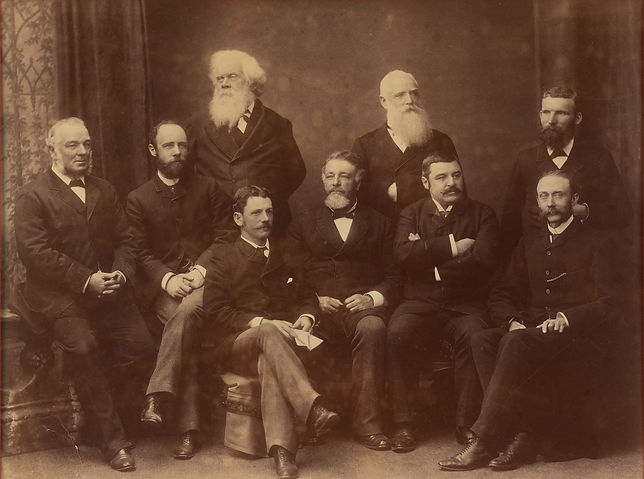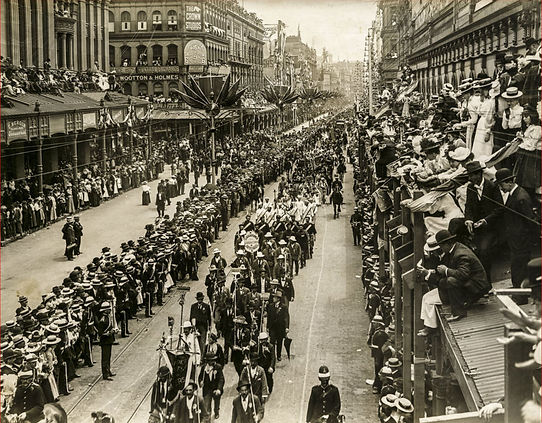Federation
The Federation of "Australia" was a defining moment in our history, bringing together the separate British colonies under a single Commonwealth while preserving their individual sovereignty. Before Federation, each colony operated independently under British rule, managing its own laws and affairs. However, growing challenges in trade, defence and governance highlighted the need for a structured union that upheld the rights of the people and the autonomy of the former six colonies. This page explores the path to Federation, from the early colonial period to the formal establishment of the indissoluble Commonwealth of Australia on January 1, 1901.

Parkes ministry (1889-1891)

Sir Henry Parkes
The Colonies Before Federation
Before the Commonwealth of Australia became a self-governing colony of Great Britian, it consisted of six separate British colonies: New South Wales, Victoria, Queensland, South Australia, Western Australia, and Tasmania. Each colony operated independently under its own government, laws, railway systems, and even military forces. While they shared a common language and allegiance to the British Crown, their separation often led to inefficiencies and conflicts, particularly concerning trade, immigration, and defence.
-
Economic Barriers – Each colony had its own trade policies, leading to tariffs and restrictions on goods moving between them.
-
Defence Concerns – Without a unified military force, the colonies were vulnerable to external threats, particularly as the world entered a period of increasing geopolitical tensions.
-
Legal and Administrative Challenges – Differing laws and regulations made travel and commerce between colonies cumbersome.
Sir Henry Parkes and the Push for Federation
One of the most influential figures in the Federation movement was Sir Henry Parkes, often referred to as the 'Father of Federation.'
In 1889, Parkes delivered the famous Tenterfield Oration, where he called for the unification of the Australian colonies under a single Commonwealth government. His speech ignited widespread discussions and led to a series of conventions aimed at drafting a commonwealth constitution.
Parkes and other key figures, including Edmund Barton, Alfred Deakin, and John Quick, worked tirelessly to convince the public and political leaders of the need for Federation.
The Road to Federation
Throughout the 1890s, representatives from each colony gathered at constitutional conventions to draft a framework for the Commonwealth of Australia. These meetings focused on:
-
Defining the powers of the Commonwealth Government while ensuring that colonies retained their sovereignty.
-
Establishing a Senate and House of Representatives to balance representation among the colonies, which would become States.
-
Creating a High Court to interpret and uphold the Constitution.
The process of drafting and finalizing the Constitution was not without its challenges. Intense negotiations were required to ensure that both smaller and larger colonies were fairly represented. Debates over trade, taxation, and the distribution of power between the Commonwealth Government and the Colonies led to multiple revisions of the proposed Constitution. A key concern was maintaining the balance of power, preventing any single colony from dominating national decision-making.
After years of deliberation, compromise, and public engagement, the proposed Commonwealth of Australia Constitution Act 1900 (UK) was put to the people in a series of referendums. Australians overwhelmingly voted in favor of Federation, paving the way for a unified Commonwealth Government to uphold the rights and sovereignty of its people.
Federation on January 1, 1901
On January 1, 1901, the Australian colonies were formally united under the Commonwealth of Australia, inaugurated in a grand ceremony at Centennial Park, Sydney. Key developments included:
-
Edmund Barton becoming the first Prime Minister of the Commonwealth of Australia.
-
Lord Hopetoun appointed as the first Governor-General.
-
The new Commonwealth Parliament established in Melbourne before later moving to Canberra.
This momentous event marked the beginning of a new constitutional order, where the former colonies became self-governing states within the Commonwealth of Australia, while still remaining part of the British Empire.
The Original Constitution & Its Intent
The Commonwealth of Australia Constitution Act 1900 (UK) was carefully crafted to uphold the sovereignty and rights of the people living in the self-governing colonies. It established a constitutional framework designed to prevent the centralization of power and ensure accountability in governance.
Key protections included:
-
The separation of powers between the executive, legislative, and judicial branches.
-
State sovereignty, allowing states (colonies) to retain control over certain affairs.
-
The rule of law, ensuring government actions remained within constitutional boundaries.
However, over time, unconstitutional actions and political maneuvering have undermined these protections, eroding the original intent of Federation. Many of the safeguards designed to prevent government overreach have been bypassed or ignored, diminishing the constitutional rights of the people under the Commonwealth of Australia Constitution.
Conclusion
Federation was intended to unite and safeguard the people of the Commonwealth, ensuring their sovereignty within a constitutional framework. Understanding the true history of the Commonwealth’s formation highlights the importance of upholding the principles enshrined in the Commonwealth of Australia Constitution Act 1900 (UK). Through education and advocacy for constitutional restoration, we can work towards upholding the rights and freedoms originally intended for all within the Commonwealth under the organic Constitution.

Federation Parade, George Street Sydney, 1901

